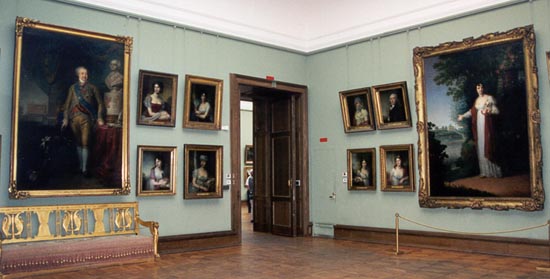
Tretyakov Gallery - classical paintings
Sunday June 13: Yesterday morning, we saw the Tretyakov Gallery -- a Getty-like collection assembled by the two brothers Tretyakov, whose wealth was acquired in major trade monopolies. One brother admired Western-European art, so half of the gallery is devoted to Russian painters of that style from the 18th and 19th century. Very similar to the Tate collection of great British landscapes and portraits. The other brother admired the Russian religious iconic paintings from churches that date back to the 15th and 16th century. This part of the gallery is very much like walking through the cathedrals of earliest Russia.
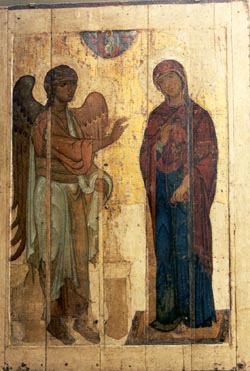
Tretyakov Gallery - icon paintingIn the evening, we saw the "new" Old Moscow Circus: a combination of small-scale, old-fashioned Barnum & Bailey clowns, horses, trained dogs and monkeys followed by a second half of the show that resembled a more modern Cirque de Soleil routine of high-wire choreography. As with much of the "old" Moscow, the building that houses the circus was once dilapidated and under-maintained until the later 1990s when private donations, combined with a Muscovichi's yearning for the "greatness that once was" made it possible to fully re-build and restore the circus according to its original plans and drawings.
On Sunday, itself, we took one full stop on the Moscow Metro -- going from Byelorussia to Myrishkova. The Metro was one of several major construction accomplishments of the Stalin era. At the first station, the interior was a tribute to the rural state of White Russia -- grain and granite in white stucco, white marble with ceilings decorated in intricate, colored tile. In the second stop, the interior was a tribute to great pilots and their war victories as well as their personal sport achievements. The stations are multiple levels deep with gigantic and FAST escalators the reach down nearly forever. Even on a Sunday, and a holiday weekend at that, people seemed to be in a special hurry to get to their destinations.
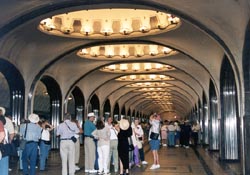
Moscow Metro
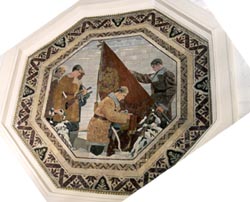
Ceiling Tile - Metro
On Friday, we ate lunch at the National Hotel -- a great meal of borscht and chicken. On Saturday, we ate lunch at the plush Marriott Hotel -- another great borscht-like soup. Beginning on Sunday, our meals were on board our boat, the M/S Krasin -- back to basics. Before the circus, they fed us again at the Aerostar Hotel and most of us were still too full from our huge lunch to enjoy the Beef Stroganoff. Plates half full of food (and more) were sent back untouched. Just way too much food for the very little exercise so far. As a result, I started taking longer walks around the narrow promenade of the boat starting Saturday: 10 laps make a mile, they say.
Sunday afternoon was a visit to the Manezh Square and close by, the Tomb of the Unknown Soldier (very much like our own in Arlington National Cemetery), an Eternal Flame dedicated to their war-dead, and a Wall of the Hero Cities of World War II.
Next we went onto Red Square -- the giant open cobblestone area with Lenin's Tomb on one side, the Kremlin Wall with the burial sites of major Soviet leaders (including Brezhnev, Stalin and John Reed, author of Ten Days that Shook the World) on a second side. G.U.M., the former state department store complex, is on a third side. G.U.M. is now occupied by very expensive European and American luxury-merchandizers (Cartier, etc.)
At the end of Red Square is St. Basil's Basilica (actually it's St. Vasili) -- a typical sight on CNN and NBC news broadcasts from Moscow. A bridge behind the Basilica is called "CNN Bridge" because film crews so predictably use it as a camera location. Our UCLA group tried to take a group photo in Red Square with St. Basil's as the background -- I think we succeeded, but were stopped in the middle of our effort by a small police-van that almost drove over the weaker members of our group. They told us to not congregate here in Red Square. After some thought, we realized that the police probably thought we were part of another, separate group of demonstrators that were in another part of Red Square, voicing their opposition to NATO and Kosovo or whatever.
Can you imagine what a blue and gold flag with the letters U.C.L.A. must have looked like to anxious Red Square security police?
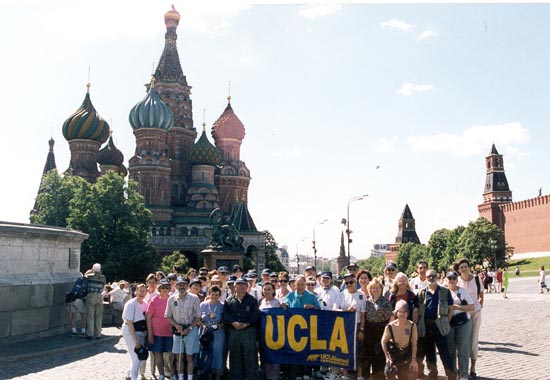
U.C.L.A. Group at St. Basil's Cathedral

